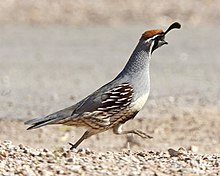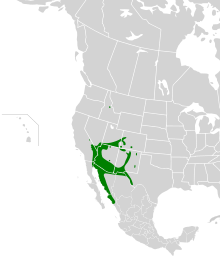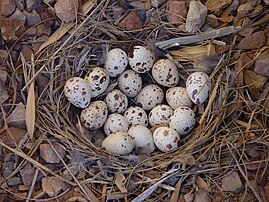Gambel's quail
| Gambel's quail | |
|---|---|

| |
| Male Gambel's quail inLas Vegas, Nevada | |
| Scientific classification | |
| Domain: | Eukaryota |
| Kingdom: | Animalia |
| Phylum: | Chordata |
| Class: | Aves |
| Order: | Galliformes |
| Family: | Odontophoridae |
| Genus: | Callipepla |
| Species: | C. gambelii
|
| Binomial name | |
| Callipepla gambelii (Gambel,1843)
| |

| |
Gambel's quail(Callipepla gambelii) is a small ground-dwelling bird in theNew World quailfamily. It inhabits thedesertregions ofArizona,California,Colorado,New Mexico,Nevada,Utah,Texas,andSonora;also New Mexico-borderChihuahuaand theColorado Riverregion ofBaja California.Gambel's quail is named in honor ofWilliam Gambel,a 19th-centurynaturalistandexplorerof theSouthwestern United States.
The species is not as widely introduced as the relatedCalifornia quail.It was, however, released onSan Clemente Islandin 1912 by Charles T. Howland et al., where it is currently still established.[2]
Description
[edit]TheCallipepla gambeliibirds are easily recognized by their top knots and scaly plumage on their undersides. Gambel's quail have bluish-gray plumage on much of their bodies, and males have copper feathers on the top of their heads, black faces, and white stripes above their eyes. The bird's average length is 11 in (28 cm) with awingspanof 14–16 in (36–41 cm). These birds have relatively short, rounded wings and long, featherless legs. Itsdietconsists primarily of plant matter and seeds.[3]
Gambel's quail can be commonly confused withCalifornia quaildue to similar plumage. They can usually be distinguished by range, but when this does not suffice, California quail have a more scaly appearance and the black patch on the lower breast of the male Gambel's quail is absent in the California quail. The two species aresister taxawhich diverged during the LatePlioceneor EarlyPleistocene,1 to 2mya.[4]
Taxonomy
[edit]Subspecies
[edit]There are two recognizedsubspecies:[5]
- C. g. fulvipectus(Nelson,1899) – fulvous-breasted quail – southeastArizonaand southwestNew Mexicoto southernSonorainMexico
- C. g. gambelii(Gambel, 1843) – nominate –UtahandNevadathroughMojave DeserttoColorado,northeasternBaja CaliforniaandTiburón Island.
Behavior
[edit]Gambel's quail primarily move about by walking and can move surprisingly fast through brush and undergrowth. They are a non-migratory species and are rarely seen in flight. Any flight is usually short and explosive, with many rapid wingbeats, followed by a slow glide to the ground. In the late summer, fall, and winter, the adults and immature young congregate into coveys of many birds. In the spring, Gambel's quail pair off for mating and become very aggressive toward other pairs. The chicks are decidedly moreinsectivorousthan adults, gradually consuming more plant matter as they mature. Gambel's quail aremonogamousand rarely breed in colonies. The female typically lays 10–12 eggs in a simple scrape concealed in vegetation, often at the base of a rock or tree.Incubationlasts from 21–23 days, usually performed by the female and rarely by the male. The chicks areprecocial,leaving the nest with their parents within hours of hatching.[6]
Gallery
[edit]-
A pair atIndianapolis Zoo(male on left and female on right)
-
Male and female Gambel's quail in Mesa, Arizona
-
Gambel's Quail nest in San Tan Valley, Arizona
-
Adults with chicks
-
Gambel's quail chicks atJoshua Tree National Park
-
Male
-
Female
References
[edit]- ^BirdLife International (2020)."Callipepla gambelii".IUCN Red List of Threatened Species.2021:e.T22679609A138721794.doi:10.2305/IUCN.UK.2021-3.RLTS.T22679609A138721794.en.Retrieved4 January2023.
- ^Huey 1932.
- ^"Gambel's Quail".Audubon.2014-11-13.Retrieved2023-01-05.
- ^Zink & Blackwell 1998.
- ^"Callipepla gambelii".Integrated Taxonomic Information System.Retrieved9 February2006.
- ^Thomson 2001.
Sources
[edit]- Huey, Laurence M. (1932)."Some Light on the Introduction of Gambel Quail on San Clemente Island, California"(PDF).Condor.34(1). Cooper Ornithological Society: 46.doi:10.2307/1363791.JSTOR1363791.
- Thomson, Matthew (2001)."Callipepla gambeliiGambel's quail ".Animal Diversity Web.University of Michigan Museum of Zoology.Archivedfrom the original on 2016-03-05.Retrieved10 June2016.
- Zink, Robert M.; Blackwell, Rachelle C. (1998)."Molecular systematics of the Scaled Quail complex (genusCallipepla) "(PDF).Auk.115(2): 394–403.doi:10.2307/4089198.JSTOR4089198.
External links
[edit]- Gambel's Quail videosat Tree of Life
- "Gambel's Quail media".Internet Bird Collection.
- Stamps[usurped](forMexico,United States) with Range Map at bird-stamps.org
- Gambel's Quail photo galleryat VIREO (Drexel University)
- Interactive range map ofCallipepla gambeliiatIUCN Red List maps
- IUCN Red List least concern species
- Callipepla
- Quails
- Game birds
- Endemic birds of Southwestern North America
- Native birds of the Southwestern United States
- Birds of Mexico
- Birds of the Rio Grande valleys
- Birds of the Great Basin
- Birds described in 1843
- Fauna of the Mojave Desert
- Fauna of the Colorado Desert
- Fauna of the Yuma Desert
- Fauna of the Lower Colorado River Valley
- Fauna of the Sonoran Desert
- Taxa named by William Gambel








